 |
 |
|
|
|
|
|
Summer
2004

Canadian Pacific Railway Employee
Communications
Room 500 401-9th Ave S.W. Calgary AB T2P
4Z4
Reinventing the
Railway
Greg Gormick
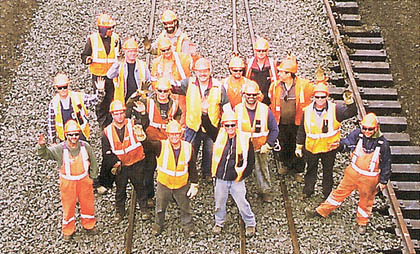
ES Southern Ontario Utility Gang Number
1
A great railway is never
finished. From the moment the last spike is driven, work begins to fine
tune and reshape it to meet the ever-evolving needs and
traffic patterns of its customers. Longer sidings, new spurs, stronger
bridges, even total route realignments - all are elements in the relentless
process of keeping its operations fluid. Piece by piece, engineering
services - and a supporting cast of thousands - is constantly reinventing
the railway.
| |
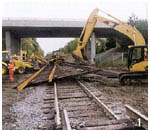
Backhoes and power shovel
lift track panel for new east end switch.
|
On the CPR, the demanding task of physically maintaining the railway is
entrusted to engineering services, which undertakes key projects every year
to increase capacity and improve traffic flow on the main lines and in the
yards. In some respects, these projects are more difficult than the
construction of the CPR's original infrastructure. The pioneer builders
worked mostly at the "end of steel"; today, engineering employees
do their jobs in the midst of a constant parade of trains that must get
through while the physical improvements are being made.
| |
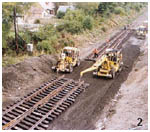
Speedswing machines pull
panel into position at end of siding
extension.
|
"To save scarce capital dollars, you first try to deal with your
capacity issues by modifying your operating plan", said Vern Graham,
CPR vice-president of engineering services. "But once
you've looked at the issue from all angeles, tried every operational
modification and find you're still fighting a capaciy constraint, then you
have to look at capital improvements".
The list of players is staggering. "You could compare it to
choreographing a ballet or performing a symphony", Vern said.
"Everyone must know not just their own part, but the parts all the
others will perform, as well. It's very complex and it takes an immense
amount of planning and teamwork to make sure it comes off safely and
smoothly, on time, and on budget".
| |
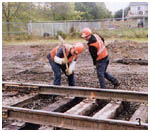
Manually driving spikes to
gauge the rails afer "roughing
in".
|
Each project is different, but there are common threads.
Take, for example, a recent Saturday morning at Mile 174.5 of the busy
Belleville Subdivision in Oshawa, Ontario. Months of planning, procurement
and construction were coming together in a grand finale. The work at Oshawa
was part of an on-going capacity expansion program on the
Montreal-Chicago corridor, probably the busiest
port-to-inland terminal rail routing in the world. A
3,000-foot siding was being extended by 7,000 feet to permit
longer and more efficient train movements. But it wasn't a simple matter
of just laying additional track and connecting it up. This siding also
included the switches that provide access to Oshawa Yard, where the
time-sensitive needs of the General Motors assembly plants are
attended to 24 hours a day.
| |
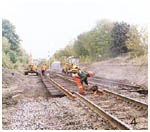
Cutting excess rail from
end of switch panel to fit the gap.
|
The job had to be done without disrupting the vital flow of main line
trains and those serving GM. It also included a grade crossing, which
couldn't be blocked, and a culvert carrying an environmentally sensitive
creek underneath the right-of-way.
For months, engineering services, signals, and communications (S&C) and
a host of other CPR and external personnel worked while trains continued to
roll under the "planned protection" provided by Rule 42 of the
Canadian Rail Operating Rules. Then came cutover day, when the new switch
and related signals had to be physically spliced into the main line to
connect it with the lengthened siding. It was no longer possible to do this
with Rule 42 protection; the crews needed to take the line out of service.
| |
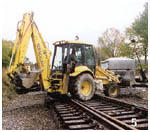
Backhoe puts switch stand
in place.
|
Some trains were held back at their originating or intermediate terminals
and some were expedited during the night in advance of the shutdown. The
highest priority trains were detoured on CN's parallel
Toronto-Montreal main line. The result was 10 hours of
uninterrupted work time - and 10 hours of pressure for engineering
services' Ontario Utility Crew #1 and their counterparts from S&C.
"We love pressure", said deputy track program supervisor Curt
Eveline with a laugh. "We're used to it. These guys have done this so
many times that it's second nature. We all know what has to be done and
we're going to it - on time and safely".
Saws whined sharply as they cut through rails. The S&C crew snipped
the connections between the rails and the old signal bungalow. Ties were
laid to fill in the gaps at the ends of the pre-fabricated
panels for the new switch, which were brought in on flat cars from Weston
Shops in Winnipeg.
Out with the old, in with the new. The Speed Swing machines and track hoes
hoisted the old switch panel out, set it off to the side for reclamation,
then toted the three sections of the new switch panel down to the waiting
gap in the main line. The S&C crew made the hardwire connections
between the track and the new signal bungalow to control it. Bolting,
welding, wiring, and grinding all went in sequence, each group of workers
doing their bit and then backing off to let their co-workers
perform the next task.
With everything in place, a locomotive shoved the
side-discharge rock cars slowly over the new track structure
to unleash controlled landslides of fresh stone ballast. The tamping
machines followed to pack the ballast between and around the ties. And
every so often, one of the most traditional of all railway sounds was heard
clearly: the ring of sledgehammers driving steel spikes deep into the
hardwood ties to secure the rails.
As the afternoon wore on, the end of track possession loomed and the
railway started to come back to life. Even as the steel gang and the
S&C crew finished up their work, the Crew Management Centre in Montreal
was ordering locomotive engineers and conductors for the trains at
terminals on either side of the track project.
The last high-priority trains were coming off the CN detour
routing. The railway was getting ready to roll again.
Shortly before 17:00, it was done. A cold drizzle began and Curt stopped to
extend the crew's thanks to Momentum. "In all the years we've been
doing this, none of us can remember anyone ever doing a story about
it", he said. "It's good to know that other employees will now
understand what goes on out here and how important these things are if
we're going to get more traffic off the highways and on to the
CPR".
Track
Structure
Today one mile of CPR main line track takes bout 252 tons of rail,
3,240 ties, six tons of spikes, 63 tons of tie plates, and 2,730 tons of
ballast.
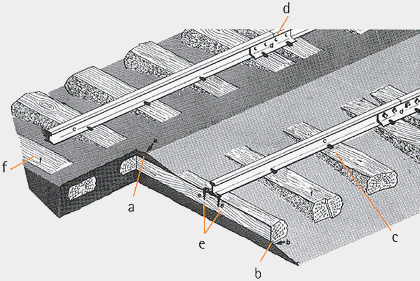
In 1881, CPR's twin ribbons of steel rail were considered a technological
marvel. The track was laid to standard gauge, 4 feet, 8 1/2 inches,
ballasted from a crown 2 inches above the center of the ties (a) and
sloping away on each side to the bottoms of the ties at their extremities
(b). The steel rail (c) was manufactured in the United
Kingdom and Europe, weighing 56 pounds per yard and suppled in
30-foot lengths. Sixty pound rail was used on heavy grades and
in areas that were mostly curved.
No tie plates were used. Joints between rails were opposite one another,
the rails being connected by four-bolt "fishplates"
or splice bars (d). Bolts were placed with heads on the inside of
the rails. One spike (e) was placed on ech side of each rail per tie.
Ties (f) were tree trunks made flat on two surfaces, with a
minimum length of eight feet. They were made from cedar, tamarack, and pine
and were not treated with preservatives as they are today.
CPR trains are now many times longer and heavier than in 1881. This demands
deeper roadbed, stronger steel, additional anchoring, and advanced
construction techniques. Although much of the right-of-way
remains the same and the distance between the rails is still 4'
8-1/2", virtually every other detail of the CPR's track structure has
changed.
CPR main line roadbed today typically consists of three elements:
a layer of clean earth sub-grade, gravel
sub-ballast, and crushed rock ballast. In total, this roadbed
may measure as much as 30 inches high.
Ties are larger and sturdier than those of more than a century ago. A
typical main line tie is 8' 6" long, 7" wide, and 5" high.
Steel plates and ballast anchors secure rail to tie and tie to ballast -
but the venerable spike is still very much in evidence. In combination, all
of these devices keep the tail properly positioned and anchored under the
tremendous weight and force of today's trains.
Standard CPR main line rail weighs 136 pounds per yard. It is produced in
78 foot sections by specialized rolling mills in Canada, the U.S., Germany,
and Japan. These are then welded into sections a quarter-mile
or more in length. Continuous Welded Rail (CWR) provides a smoother ride
and requires less maintenance than bolted or jointed rail. It has also
virtually eliminated the age-old
"clickety-clack" sound.
Today one mile of CPR main line track takes bout 252 tons of rail, 3,240
ties, six tons of spikes, 63 tons of tie plates, and 2,730 tons of ballast.
If you could find a location where it was possible to build perfectly
straight and level track - no curves, switches, bridges, or other civil
works - it would cost about $1 million per mile.
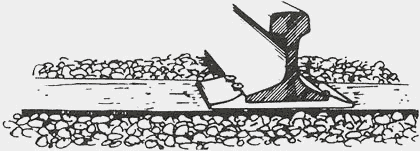
This Momentum
article is copyright 2004 by Canadian Pacific Railway and is reprinted
here with their permission. All photographs, logos, and trademarks are
the property of the Canadian Pacific Railway Company.
|
|
|
|